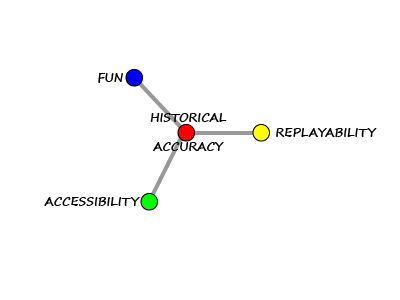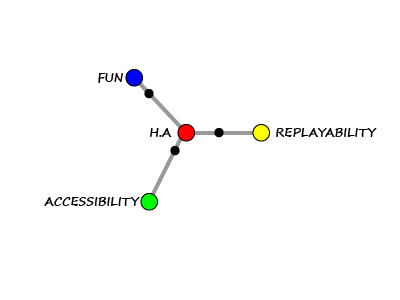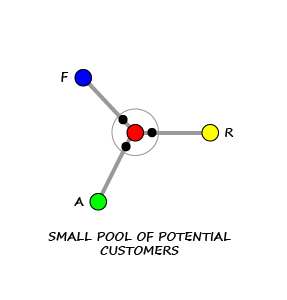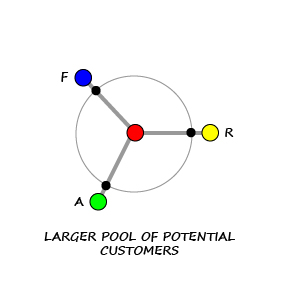Work continues at a steady pace on DC3 : Barbarossa but we are starting to give some thought to what comes next.
While there are plenty of obvious candidate conflicts that would benefit from a similar treatment we are pondering something much more fundamental.
Take the following. It’s straight out of my head and highlights four key design elements.
Fun is obvious. No point making a game if it isn’t fun. The higher up the fun scale you can climb the better.
Replayability is important although these days a lot of games are designed to be played once and then forgotten about. Reliving the game through multiple play throughs isn’t as important as the ‘experience’. Once it’s done, it’s done. Move onto the next shiny light.
Is this something we’d like to emulate?
No. We firmly believe that a game should be able to deliver over a prolonged period of time.
Historical accuracy is something that can be safely ignored in a lot of genres but if we are discussing military orientated games then it’s a definite consideration.
Accessibility is the murkiest of the four. By this I mean how easy is it for a Player to drop into the game cold and get going? The Civilisation series are highly accessible. You start with a few units on a small section of revealed map. There are very few moving pieces and only a few decisions required. It’s very easy to sit down and play with the games involved and intermeshing mechanics being introduced gradually over time.
These interact in a variety of ways. Having them in a square layout doesn’t make much sense for a war game. I’d shuffle them around into a starfish with historical accuracy at the centre.
Taking DC3 : Barbarossa as a example I’d call it like this (below). This is a subjective assessment from the designer of the game so your views may differ but, for the purposes of discussion, it’ll do.
The slider between historical accuracy and accessibility is all one way traffic. The game has a lot of UI elements to smooth the learning curve but it still presents a new Player with a whole mess of counters and complicated mechanics right up front.
This is the inevitable nature of a set piece historical recreation. Accessibility is going to suffer.
Replayability takes a hit as well. DC3 : Barbarossa took the approach of providing a detailed, in-depth campaign with a lot of features that enhance replayability but there is no getting around the fact that every time you play you are recreating the same military endeavour.
Once again another consequence of a game centred around a set piece historical battle
What about fun? Does a strong adherence to historical accuracy preclude having fun? No it doesn’t. What does change is the type of fun. The person who plays an historical war game gets enjoyment out of an immersive experience full of interesting decisions rather than the pure adrenalin rush that comes from a cinematic shooter.
War games in general offer a very dry, cerebral type of fun. DC3 : Barbarossa goes a step further by making people a big part of the game in an effort to negate this. Dealing with people is always going to be more enjoyable than a straight diet of applied numbers.
Is it a step to far to say that fun is independent of historical accuracy? That one doesn’t influence another?
DC3 : Barbarossa has a very strong historical focus. Certain areas of historical fidelity have been deliberately streamlined whereas others are extremely detailed. Overall I’d score it, relative to typical war games, quite high on the historical scale.
It’s also a lot of fun. Which would give credence to the view that a game can be fun regardless of how historical it is. The two elements are independent of each other. My star fish model should reflect this.
All this provides a basic design model for a war game. We could give D-Day, the battle of the Bulge, the Soviet drive on Berlin, the African campaign, or others, the DC3 treatment and we’d end up with a similar looking starfish.
Which is a possibility.
The star fish depicted above – we’ll call it the DC war game starfish – has a strong appeal to a certain type of player. How big is this pool of players?
Hard to say (although we’re getting a good idea with the release of the third game in the series) but I’d go out on a limb and say that the closer the three sliders are to the historical starfish heart the smaller that pool. Conversely the further out the sliders move along the radial arms of the starfish the larger the pool.
Examples of both could be the aforementioned Civilisation series at one end of the scale and perhaps a hypothetical ‘Monster’ type of war game at the other that overflows with complexity and counters. Once again a subjective viewpoint by myself but Steam Spy tells me that the latest iteration of Civilisation has sold north of 8 million copies.
Could you call it an historical war game? I think you probably could but one that has a very loose historical affiliation befitting it’s emphasis on replayability, accessibility and fun.
A more interesting question is whether my hypothetical monster war game with it’s hyper focus on historical accuracy at the expense of all else could sell as well? Even if it was a really fun experience would the lack of accessibility and replayability – eg. The massive time investment, the huge amount of counter shuffling, the complex mechanics, the repetitive replaying of the same conflict – still preclude it from climbing the best seller list?
Back to our war game star fish above. There are some big implications here. The further the game moves away from a strict historical adherence to the facts the more scope there is to enhance replayability and accessibility. Increasing the degree of both of these may well increase the potential pool of customers, a-la-Civilisation.
Unfortunately, in my war game model, replayability and accessibility directly conflict with historical fidelity. The closer the game tracks what happened historically, the lower the degree of replayability and accessibility available.
Take an example such as Finland in DC3 : Barbarossa. Historically it entered the war against Russia on a certain date. If we moved the historical slider all the way into the centre of the starfish then that’s going to be exactly when it initiates hostilities in the game – always. Replayability has sunk to zero in this instance as a player knows exactly what is going to happen and can plan around it.
Alternatively we could shunt the slider all the way out to the end of the radial starfish arm and have Finland invade Russia at any point in the game to the extent that in some games they’ll just sit there doing nothing the whole time. Replayability is maxed out. Who knows what those crazy Finns will do in a given play through? But what about historical accuracy? What Axis player is going to accept a potentially inert, comatose Finland?
‘Hey, they attacked in ‘41, what’s going on here?’
Accessibility is similarly opposed to historical accuracy. Who would be willing to play a game about Operation Barbarossa that started with a few unit counters on either side? Would promises that more will arrive over time, once you get familiar with the game, be enough to placate players? Could they blitzkrieg their way into a near empty Mother Russia with a solitary Panzer Division?
I doubt it. They expect to see a full, historically correct, line up of Armies and Panzergruppes as well as access to the full suite of game mechanics right from the get go. Any dilution of the number of units or game mechanics that is done to ease players into the experience would be viewed as straight out historical heresy.
Hence my starfish war game model. You can have historical accuracy OR you can have replayability and accessibility. Of course you can move the slider to various points in between but in doing so you are compromising one element in favour of another.
Vic points out, rightly, that this isn’t necessarily so. An historical war game could still remain accessible to the general public if it featured a high level of automation. It could also have an extended time line that could offer divergent play and increased replayability.
It’s not cut and dried and I’m certainly no expert on the subject.
So does meant the end of the road for the grognard orientated Decisive Campaign series of games? No.
It can be quietly satisfying to create a detailed historical simulation. There is a definite market for these type of games however at this point we are thinking big picture and aren’t ruling anything in or out.
I’ll finish this with a few questions as we’d like to see what other people’s views on the subject are.
Cheers,
Cameron








Hi Cameron,
I think there are four important features in any game:
1-AI: Everybody wants a challenging AI
2-Replayability: Anyone loves replayability
3-Graphics/UI: All os us enjoy nice graphics
4-Realism: Some people prefer strict historical settings, others more flexibility.
As you can see people with different opinions could agree in 3 of the 4 points. A game with a poor AI is incomplete (lack of soul); a game without replayability has short-life; a game with dated or ugly graphics is not attractive for customers. But… what happens to an unrealistic game? It is not neccesarily a bad one.
Realism depends of personal tastes but it´s not an indication of quality. Developers who want to create a good game should spend most of their effort in points 1-3. Unfortunately nowdays there are too many developers that tend to ignore these three important points and concentrate mainly in point 4 (pure historical recreation).
Advanced Tactics and Decisive Campaigns are different in point 4, but both of them are really good. Again, the main difference is the realism.
Cheers
I believe the goal of Historical Accuracy is incorrectly interpreted as following the exact historical path, where I see it as starting with an accurate representation of the conflicts forces, dynamics, and information such that future decisions and outcomes could result in the historical path, but reasonable different decisions would branch from that starting point. So, the tension between Historical Accuracy and Replayability may be less than you propose. Incidentally, scenarios are a great way to address both of these dimensions.
The ideal game would include significant and realistic automation, to provide both a less overloaded introduction to a large complex situation, but also to enable varying of the game experience.
From a business standpoint, while a decreased focus on Historical Accuracy could ease advancements on other dimensions, anybody can do that. VR Designs seems to have established a proven niche in successfully wedding high Historical Accuracy with a Fun, Replayable, and reasonably Accessible product. Especially if you continue to support and refine your products, you should have a loyal customer base – if you change that commitment to Historical Accuracy, you’ll lose most of them.
Thank you for DC3.
Excellent post – I think I see what you’re thinking about – how to keep the grognards and yet increase the purchaser base.
One thing which might help A LOT is to have Vic’s wonderful AI usable by the player.
Let’s take DC3 as an example. Somebody might be intrigued by being Halder and overseeing the invasion of the Soviet Union but when they realize they have to push dozens/hundreds of divisions around in complex, number-filled dances to get the job done – they quit.
Why not let them set their armies to AI control as an option?
For a grognard, like me, that would not be an option I would EVER choose! No insult to Vic, but no AI is ever as perceptive as a human (even me!). For a more casual player they might enjoy giving the big picture orders, a measure of combat priorities and watching how the computer generals (AI) get things done.
This could increase the player base by a factor of two (maybe more) without really overhauling the basic DC engine and system (which is much admired and loved by anyone who has played it).
Just my two cents worth – you guys are at the cutting edge of where computer wargames are going and I appreciate the ability to see the ideas you are brainstorming.
All the best.
The age old tension between ‘historical accuracy’ and “fun and replayable” just continues on and on. Obviously there are, speaking rather broadly, two camps here. Those who like high historical accuracy and those who like a game loosely based on a historical time (WW2) with very high replayability. I would put DC:B in the high historical camp and Advanced Tactics Gold (ATG) in the fun and replayable camp. That is not to say DC:B isn’t fun as I’m sure that it is. Since I don’t have access to sales data I can’t state which game type is more prosperous for those who sell them. My hope is that the market is large enough to support both. I do know that I have been playing and still play Advanced Tactics, since about 2008. ATG has a random game engine that just keeps me coming back for more. It sure would be nice to see ATG updated and expanded at least one more time.
To my mind fun is NOT a part of any game, it is EVERYTHING in a game. The funniest games I own are those which I spend a lot of hours, this is the appropiate test to know the best ones. Indeed games are for fun.
To my mind fun is NOT a part of any game, it is EVERYTHING in a game: powerful AI, pretty graphics, technical optimization, replayability, etc. The funniest games I own are those which I spend a lot of hours, this is the appropiate test to know the best ones. Indeed games are for fun.
Great piece of analysis but I’m not sure I agree with the reasoning entirely.
Accessibility is one of the most important things determining the potential audience size of a game, regardless of genre. Everyone can be tempted to try something, but the longer it takes to figure out how to play, the smaller the group of people that keeps on trying.
Complexity of the game’s underlying systems is a second axis that determines the potential audience size. A very complex game scares people away who don’t think that solving complex puzzles in space and time is something they want to do to relax (they’re strange, I know).
Replayability is determined by the number of starting states and the number of ways that state can be changed by the player. Replayability can be enhanced by increasing the number of starting states, which is what Civilization does when it generates a random world, or by having an underlying system of actions and consequences that are hard to predict in the long term, which is something that Chess is very good at.
Historical accuracy is more of a constraint applied to the game. It has an impact on Replayability because the game can only offer a single starting state, i.e. the historically “correct” one. Anything other is simply “not” historically accurate, but we wargamers accept them as “what if?” scenarios that could have happened. This can add to replayability at the cost of historical accuracy.
Historical accuracy is also determined by the complexity of the game’s systems mostly because things that have some kind of historical precedent, something like “it took 10 T-34’s to knock out a single Tiger”, are expected to happen by the people playing the game. If a single T-34 knocks out 10 Tigers and there is no (believable) explanation for it, then the game is not _considered_ historically accurate, even if it tracks every round fired and amount of toilet paper consumed. These kind inaccuracies are usually the result of a certain abstraction level chosen to model the game at and are essentially unsolvable (at least until quantum computers fulfill their promise and are priced at current laptop/PC levels). The only thing a developer can do, is increase the level of detail at which the game is modeled, essentially turning it into a (huge) simulation, or apply a some kind of warped statistical model to the combat routines so that everything averages out to “historically accurate” numbers over time (yuck).
Accessibility has nothing to do with historical accuracy, complexity or replayability. It is simply a result of the developer’s decisions in how the game communicates with the player and how the player (is allowed to) communicate with the game. The human-machine language vocabulary, so to speak. And it is here, that wargames (with some exceptions) have failed to outgrow their boardgame ancestry.
Civilization is mentioned in the article as an example of a strategy game with high replayability, low historical accuracy and good accessilibity. It also looks good and sounds great, which is always a plus in entertainment products. I personally haven’t played Civ V in years, because the design has become so “streamlined” that it looks like a very skinny cat with all the bones sticking out. There are many systems at play, but they are not hard to grasp and the game, for me, has become boring and unexciting. They basically lowered the tile and unit count so that more people could keep enough of the game state in their heads so they could play it, with great commercial success.
But let’s look at a game that has very complex systems interacting with each other, lots of details modeled but also sold a LOT of copies: Cities Skylines.
Cities Skylines has over 2 million owners according to SteamSpy and is not nearly as “streamlined” as Civilization. Actually the opposite is true, you have to do just about everything yourself: build infrastructure, designate zones, define bus/train/subway routes and then toy with things like taxes and such. I also think it is one of the most “accurate” (not historical, of course) city simulators ever made, even if it cannot model a real existing city (yet?). I think the main reason for its success is its great accessibility.
You can do tons of stuff to your city. So you have a very rich vocabulary at your disposal to tell the game what you want done. This gives a feeling of great control. Learning this vocabulary is done by tying the number of options to the growth of the city, so it feels natural and not artificial.
In the other direction, the game talks to the player in a myriad of ways. Since each citizen and vehicle is modeled and tracked, you can actually see what is happening on the ground in terms of everyday things. No numbers to interpret, symbols to memorize, what you see is what is actually happening. Various graphs, overlay charts and special views are available to give you insight into how things are running and almost everything is presented in a visual and contextually relevant manner, not endless rows of numbers. This rich visual language allows players to learn the game the easy way: by seeing the effects of things they do in terms they already understand. If something goes wrong in your city, the game pro-actively alerts you to it, provides overlays for you to spot the spatial relationship between the cause of the problem and possible solutions and then you can go in and fix it (which then causes other problems, so you go and fix them, etc, and there you have your core gameplay loop).
And finally: the game looks good and sounds great, which is always a plus in entertainment products ;-)
So I definitely believe that there exists a broader market for highly detailed, complex and historically accurate wargames, but ONLY IF:
1. you solve the accessibility issues current wargames are plagued by
2. make it look good
3. and make it sound great
Because let’s be honest: looking at 100,000 citizens going to work every day is actually kind of boring (the fun of the game is in building the city), we’d rather watch 100,000 soldiers, tanks and airplanes gather for an offensive and let them loose on an unsuspecting enemy and see what happens next…
Just started WTP game and am excited about this project. I love the Case Yellow (?) invasion of France game scale of 6 mi.s/hex 1 day turns. I have suggestions but not sure where to post them, so I suppose here is a good place to start.
Terrain Suggestions:
– terrain for Heavy Woods could be darker or a bigger contrast from Lt. Woods.
– Major Rivers need to be bolder, or bigger contrast w/Minor Rivers.
– permanent National Borders are needed! Not sure why they aren’t already included.
– there are a lot of Hvy Urban hexes. I could be wrong, but are all these correct?
– there should be a different symbol for Fortifications, something that can be seen even when a unit is on them. Maybe along hexsides? The ‘eyeball’ symbols don’t do it for me.
Gameplay Suggestion: for games against the AI, since it lacks a strategy for a continuous front, it should have better ZOC’s. Maybe a locking ZOC? or increased AP cost to enter one?
New Scenario Request: Belgium signs Defense pact w/ West. Allied forces are allowed to begin game inside Belgium but because of Belgium fears of antagonizing Germany any further, are only allowed to be positioned no closer than the Dyle River (or something to this effect), and dug-in.
Future Game Proposal: Overlord – Invasion of Europe, Spring 1944
– 2-3 mi./hex, x2 turns per day until the outbreak, then if possible, convert to 6 (or 10?) mi.s per hex after the outbreak. There is no other computer game out there at this scale. This would be the first!
Keep up the good work!